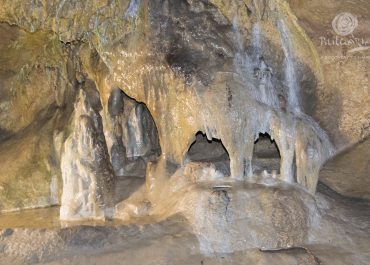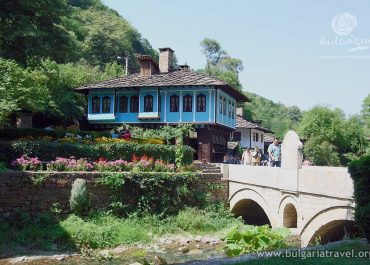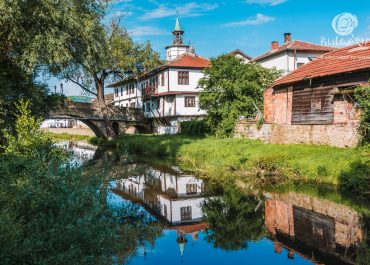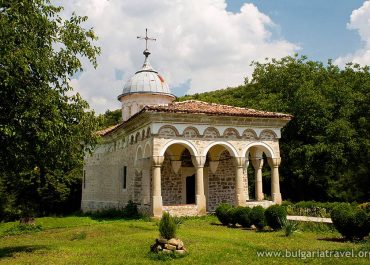
Holy Forty Martyrs Church, Veliko Tarnovo
The Holy Forty Martyrs Temple is one of the most emblematic medieval churches in Veliko Tarnovo. It is located at the foot of Tsarevets Fortress. The temple has been a monument of culture since 1964 and is closely related to the history of Bulgaria. It was built and its walls were painted in honour of the victory of Tsar Ivan Asen II over Theodore Komnenos Doukas, ruler of Epirus, in the Battle of Klokotnitsa on March 22, 1230.
The church is composed of two parts: an oblong basilica with six columns and an annex added later to the western side of the building.
It is believed that the Asen Dynasty (a Bulgarian royal dynasty that ruled in the period 1187 – 1280) built a monastery surrounding the church at the end of the 12th century. It was referred to as the Great Lavra and the Royal Monastery in the historical sources from the 12th – 14th centuries and was one of the most important medieval monasteries in the Tarnovo Region.
The conquering of Tarnovo by the Ottomans led to the decline of the monastery. The social stratum (the Bulgarian aristocracy) that took care of the church and the monastery perished, and the Christians grew smaller in number. The church served the Christians living in the neighbourhood until the 14th century when it was transformed into a Muslim mosque. This was precisely what saved the temple because all Christian temples on Tsarevets Hill and Trapezitsa Hill were destroyed during the Ottoman rule (1396 – 1878).
After the Liberation of Bulgaria in 1878, the temple was converted back into a Christian church.
Of the wall-paintings that survived, the ones of St. Elizabeth with baby John the Baptist (above the entrance) and St. Anne are of interest to visitors.
Bulgarian tsars Kaloyan (who reigned in the period 1197 – 1207) and Ivan Asen II (1218 – 1241), St. Sava of Serbia (1175 – 1235), Tsaritsa Anna Maria (1204 –1237) and Tsaritsa Irene Komnene Doukaina are all buried in the church.
The Orthodox temple also preserves some of the most significant ancient Bulgarian epigraphical monuments that give account of the great deeds of Bulgarian tsars (kings), such as Omurtag’s Column, Asen’s Column and the Border Column from Rodosto Fortress dating back to Khan Krum’s reign (803 – 814).
The church is a branch of the National Museum of History in Sofia. Today the Holy Forty Martyrs Temple functions as a museum and is open for visitors, as holy liturgies are served in it on the biggest Christian holidays.
April-October: 9.00 – 18.00
November-March: 9.00 – 17.00
The entry of visitors is suspended 1 hour before the end of working hours.
Prevention: Monday 9.00 – 12.00
Guides at the church provide services for tourists. Lectures are given in Russian, English, Italian, and German.
Tourist information center “Tsarevgrad Tarnov”
Head office – Veliko Tarnovo 5000, 5 Hristo Botev Str
November-March
Monday-Friday 9:00 -18:00
April-October
Monday-Friday 9:00 -18:00
Tel:
+358 62 622 148
+359 887 659 829
Tel:
+359 62 600 768
+359 886 640 100
E-mail:
tic@velikoturnovo.info
office@velikoturnovo.info
Website: http://www.velikoturnovo.info/bg/
Second office – Veliko Tarnovo 5000, 27 Nikola Piccolo Str.
April-October
Monday-Friday 9:00 – 18:00
Saturday and Sunday 9:00 – 17:00
Holy Forty Martyrs Church
Asenov district, Veliko Tarnovo
Tel:
+ 359 885 105 282
+ 359 62 638 841
Website: http://www.velikoturnovo.info/
The Holy Forty Martyrs Temple is one of the most emblematic medieval churches in Veliko Tarnovo. It is located at the foot of Tsarevets Fortress. The temple has been a monument of culture since 1964 and is closely related to the history of Bulgaria. It was built and its walls were painted in honour of the victory of Tsar Ivan Asen II over Theodore Komnenos Doukas, ruler of Epirus, in the Battle of Klokotnitsa on March 22, 1230.
The church is composed of two parts: an oblong basilica with six columns and an annex added later to the western side of the building.
It is believed that the Asen Dynasty (a Bulgarian royal dynasty that ruled in the period 1187 – 1280) built a monastery surrounding the church at the end of the 12th century. It was referred to as the Great Lavra and the Royal Monastery in the historical sources from the 12th – 14th centuries and was one of the most important medieval monasteries in the Tarnovo Region.
The conquering of Tarnovo by the Ottomans led to the decline of the monastery. The social stratum (the Bulgarian aristocracy) that took care of the church and the monastery perished, and the Christians grew smaller in number. The church served the Christians living in the neighbourhood until the 14th century when it was transformed into a Muslim mosque. This was precisely what saved the temple because all Christian temples on Tsarevets Hill and Trapezitsa Hill were destroyed during the Ottoman rule (1396 – 1878).
After the Liberation of Bulgaria in 1878, the temple was converted back into a Christian church.
Of the wall-paintings that survived, the ones of St. Elizabeth with baby John the Baptist (above the entrance) and St. Anne are of interest to visitors.
Bulgarian tsars Kaloyan (who reigned in the period 1197 – 1207) and Ivan Asen II (1218 – 1241), St. Sava of Serbia (1175 – 1235), Tsaritsa Anna Maria (1204 –1237) and Tsaritsa Irene Komnene Doukaina are all buried in the church.
The Orthodox temple also preserves some of the most significant ancient Bulgarian epigraphical monuments that give account of the great deeds of Bulgarian tsars (kings), such as Omurtag’s Column, Asen’s Column and the Border Column from Rodosto Fortress dating back to Khan Krum’s reign (803 – 814).
The church is a branch of the National Museum of History in Sofia. Today the Holy Forty Martyrs Temple functions as a museum and is open for visitors, as holy liturgies are served in it on the biggest Christian holidays.
April-October: 9.00 – 18.00
November-March: 9.00 – 17.00
The entry of visitors is suspended 1 hour before the end of working hours.
Prevention: Monday 9.00 – 12.00
Guides at the church provide services for tourists. Lectures are given in Russian, English, Italian, and German.
Tourist information center “Tsarevgrad Tarnov”
Head office – Veliko Tarnovo 5000, 5 Hristo Botev Str
November-March
Monday-Friday 9:00 -18:00
April-October
Monday-Friday 9:00 -18:00
Tel:
+358 62 622 148
+359 887 659 829
Tel:
+359 62 600 768
+359 886 640 100
E-mail:
tic@velikoturnovo.info
office@velikoturnovo.info
Website: http://www.velikoturnovo.info/bg/
Second office – Veliko Tarnovo 5000, 27 Nikola Piccolo Str.
April-October
Monday-Friday 9:00 – 18:00
Saturday and Sunday 9:00 – 17:00
Holy Forty Martyrs Church
Asenov district, Veliko Tarnovo
Tel:
+ 359 885 105 282
+ 359 62 638 841
Website: http://www.velikoturnovo.info/
Virtual map
Photos
© All images, advertising and video materials and/or other information published on this website are property of the Ministry of Tourism and are protected by the Law on Copyright and Related Rights, according to the Bulgarian laws to all applicable international and relevant acts of the European Union.





